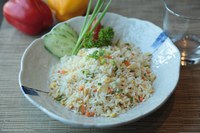Prairie Fare: Could rice be a foodborne illness hazard?
(Click an image below to view a high-resolution image that can be downloaded)
My husband and I took bites of the rice on our plates at the same time in the restaurant. We looked up at each other immediately.
The rice was at room temperature. We expect cooked food to be served hot.
I pointed at the rice with my fork and mouthed, “Don’t eat it.”
The rest of our food was not particularly hot either. I could not ask to inspect their kitchen because I am not a badge-carrying health inspector. I have, however, trained hundreds of students and professionals about food safety, so I was thinking about the possibilities.
I knew that mishandled rice has been implicated in many foodborne illness outbreaks.
One busy person was serving as the host, server and cashier in a good-sized restaurant. Was our food plated and left on a counter? We did not know the length of time the food had been sitting outside of temperature control.
Or, had the food been made earlier in the day and not held hot on the serving line? Was their hot-holding equipment malfunctioning?
Eating room-temperature rice was not worth the risk. Technically, cooked food served to the public must be at a minimum of 135 degrees Fahrenheit, according to the Food Code issued by the Food and Drug Administration.
Why was I worried about the rice? Heat-treated plant foods such as rice have been linked to many foodborne illness outbreaks. Experts estimate that more than 63,000 people are sickened annually in the U.S. from a microorganism associated with mishandled rice.
When cooked rice and other starchy foods, including pasta and potatoes, are held at lower temperatures, the bacteria can produce toxins in the food. That was my concern.
Rice, for example, can contain Bacillus cereus, a type of bacteria that can produce a heat-stable toxin (poison) in food. When rice is properly cooked and stored, it does not cause a problem.
If I had taken the potentially contaminated rice home and cooked it to a high temperature, I would not have been able to inactivate the toxin.
In fact, the usual type of toxin in mishandled rice can cause vomiting and sometimes diarrhea within 30 minutes to five hours. Another syndrome associated with this bacteria can cause diarrhea within 16 hours. In both cases, the symptoms disappear within a day or two but could have more serious effects among older and younger age groups.
We left the rice on our plates. The risk was not worth it. I need to let the health department know about this, I thought.
“I’m feeling a little twinge,” my husband said as we were leaving. I wasn’t sure if he was serious or kidding.
We were about 15 minutes from home. Step on it, I thought to myself as he drove us home.
I only had my purse in the car, not a barf bucket. I was not ready to sacrifice my new purse. Fortunately, we did not get sick.
If the restaurant had not been so busy and understaffed, I would have let the server know. We probably should have assessed the situation and left before ordering food.
I am hoping that two large piles of rice on our plates gave an indication of our dissatisfaction with the food.
I will discuss this incident with a local inspector, or my conscience will bother me that I'm putting others at risk.
Is it possible to have safe rice? Of course. We eat rice regularly in our home and in restaurants.
When making rice, follow the usual food safety rules. Wash your hands before beginning to cook, and follow the cooking directions on the package.
If you are cooking rice ahead of time for your family or guests, hold it hot. That means 140 degrees Fahrenheit according to the U.S. Department of Agriculture’s home food safety rules. Measure the temperature with a food thermometer to be sure the food is hot enough.
Keeping hot foods hot will prevent the growth of bacteria and the production of toxins.
If you decide to make rice ahead of time and serve it later, follow some additional rules. Cool it quickly. Divide the cooked rice into small containers only two or three inches deep. A metal container, such as a cake pan, cools food faster.
Use the properly refrigerated leftover rice within a few days.
If you ever doubt the safety of food at home or in a restaurant, take the safe route.
Here’s a recipe from the Iowa State University “Spend Smart. Eat Smart.” program. It uses higher-fiber brown rice in place of white rice, but the same food safety rules apply.
Fried Rice
3 eggs (lightly beaten)
2 tablespoons oil (canola, vegetable or peanut)
1/2 cup onion, chopped
2 cloves garlic, minced (or 1/2 teaspoon garlic powder)
3 cups brown rice, cooked and cooled
2 cups frozen vegetables, thawed
2 tablespoon low sodium soy sauce (or to taste)
Heat a large skillet or a wok over medium heat. Spray with nonstick cooking spray. Add eggs. Cook and stir for 3 minutes or until eggs are firm. Set eggs aside on a plate. Add the oil to the skillet. Heat over medium heat. Add onion and garlic. Cook and stir for 3 minutes. Stir in the rice, vegetables and soy sauce. Cook and stir for 3 minutes or until heated through. Stir in eggs.
Makes eight servings. Each serving has 175 calories, 6 grams (g) fat, 6 g protein, 25 grams carbohydrate, 3.5 g fiber and 190 milligrams sodium.
(Julie Garden-Robinson, Ph.D., R.D., L.R.D., is a North Dakota State University Extension food and nutrition specialist and professor in the Department of Health, Nutrition and Exercise Sciences.)
NDSU Agriculture Communication – Feb. 8, 2024
Source: Julie Garden-Robinson, 701-231-7187, julie.garden-robinson@ndsu.edu
Editor: Elizabeth Cronin, 701-231-7881, elizabeth.cronin@ndsu.edu




